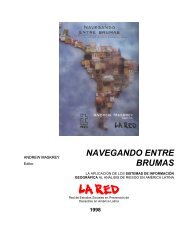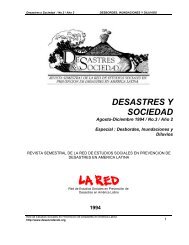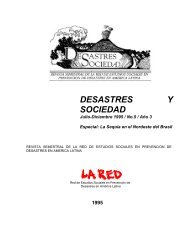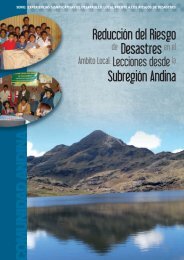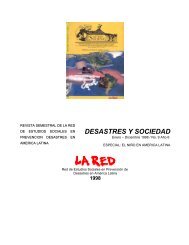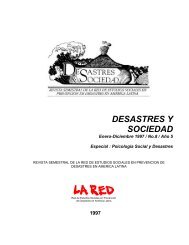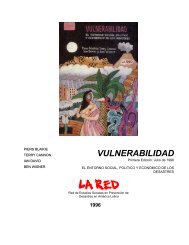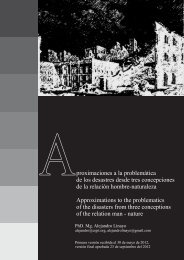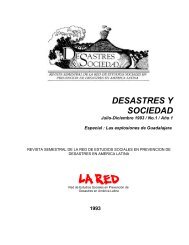Estrategias sociales de prevención y adaptación Social ... - La RED
Estrategias sociales de prevención y adaptación Social ... - La RED
Estrategias sociales de prevención y adaptación Social ... - La RED
Create successful ePaper yourself
Turn your PDF publications into a flip-book with our unique Google optimized e-Paper software.
Yet controlled flooding was a time-honoured practice in the Netherlands to <strong>de</strong>al with<br />
excess water influx. “Calamity pol<strong>de</strong>rs” were assigned in there sparsely populated eastern<br />
regions. Inhabitants were aware that they lived in “calamity pol<strong>de</strong>rs” and would be compensated<br />
for their loss (Klijn and Van Der Most 200x). The plan revived ancient history in that<br />
very region – until <strong>de</strong>ep into the 20 th century two sluices were built which were customarily<br />
opened each year on 11 November to inundate the pol<strong>de</strong>r Inundation served the purpose of<br />
counter pressure against dikes to prevent dike breaches, and fertilisation through sedimentation<br />
left behind by the water (Warner, Roth, Winnubst, 2006).<br />
Ice floes would damage dikes and dike breaches occurring each year forcing people to<br />
live higher up or flee to artificial mounds.<br />
The river changed course all the time, and upstream and downstream water boards quarrelled<br />
all the time (Roth et al., 2006). Engineering works reduced the size of the river and<br />
stabilised its course. In 1926 the practice of inundation stopped.<br />
But for the Ooij citizens, the threat were also administrative – the nearby city of Nijmegen,<br />
one of the ol<strong>de</strong>st towns in the Netherlands, had set its sights on the pol<strong>de</strong>r as early as<br />
1900. Repeated attempts were resisted. Nijmegen wanted to increase the bend in the river<br />
Waal to enable bigger ships to navigate the river – the Waal branch of the Rhine is the most<br />
busily transportation route in Europe. In 1995 and 1998 dike reinforcement led to protests<br />
and in 2000 the pol<strong>de</strong>r was <strong>de</strong>signated “calamity pol<strong>de</strong>r statuses after a study by Haskoning<br />
exploring potential for the area as a retention area (ibid.).<br />
Resistance took place at five levels (Warner, 2008). After the provincial authorities and<br />
Chamber of Commerce took an early lead (1), the mayor of Beek and Ubbergen carried the<br />
flame (2), a local civic platform emerged (3) in 2002 instigated by the local rabo Bank’s<br />
branch office, which lobbied national politicians (4). These four groups however would not<br />
have been co successful without the tacit support from a “fifth column” within the state<br />
apparatus, who our interviewees suggest leaked a critical report to the local platform (Froth<br />
et al., 2006). This and other reports un<strong>de</strong>rmined the assumptions and calculations ma<strong>de</strong> to<br />
un<strong>de</strong>rpin the rationale for the selection and <strong>de</strong>signation of the pol<strong>de</strong>r for controlled flooding.<br />
The water vice minister was forced to backtrack in 2005, although it should be observed<br />
that the plan was shelved, not abandoned.<br />
As an intermediate solution, the Ooij platform accepted the compartmentalisation of<br />
the area, more in line with Van Ellen’s i<strong>de</strong>a for Bangla<strong>de</strong>sh in the 1990s as part of that<br />
country’s Flood Action Plan. Monsoon flood water was to be drained in a finely grained<br />
network of sluices, whose doors would be <strong>de</strong>mocratically opened and closed (Warner,<br />
2010). Prof van Ellen, opposed to control flooding in his backyard, was one of the Panel of<br />
Experts. This carried an interesting irony as the Querdamm built between Ooij and Düffel in<br />
the 20 th century ma<strong>de</strong> sure an event would only flood the Ooij - not the Düffel.<br />
Building on Mounds. Another way of accepting floods is to build mounds while leaving the<br />
area exposed to regular flooding. This is now practiced in some “Space for the River” pilot<br />
projects. Building on mounds is in fact<br />
37



